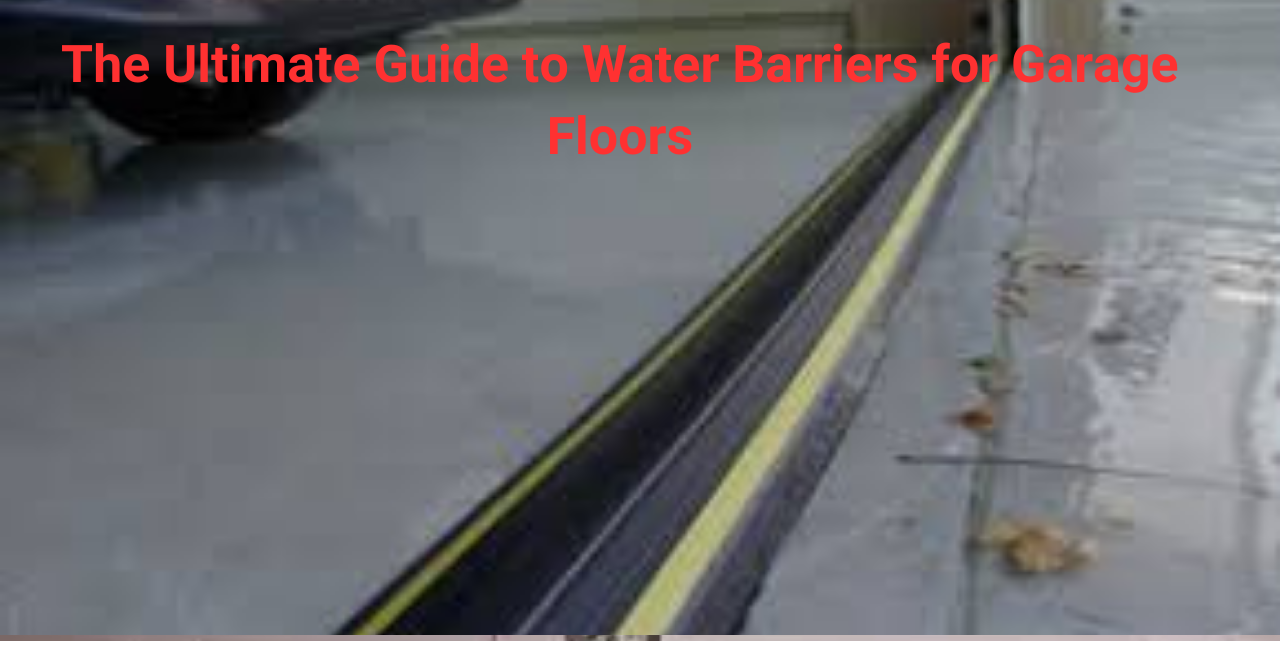When it comes to protecting your garage and its contents, one of the most crucial elements is safeguarding against water damage. Whether from heavy rainfall, snowmelt, or even daily washing, water can easily find its way into your garage, causing significant damage over time. In this comprehensive guide, we will explore the importance of a water barrier for garage floors, the different types available, how to install them, and tips for maintaining a dry and secure garage space.
The Ultimate Guide to Water Barriers for Garage Floors
Why You Need a Water Barrier for Your Garage Floor
Water barriers are essential for preventing moisture from seeping into your garage. Without adequate protection, water can cause a variety of problems, including:
Structural Damage
Water can weaken the foundation and structure of your garage. Over time, repeated exposure to moisture can lead to cracks in the concrete, compromising the stability of the entire structure.
Mold and Mildew
Damp environments are perfect breeding grounds for mold and mildew. These fungi can cause health issues and unpleasant odors, and they can also damage your belongings stored in the garage.
Damage to Stored Items
Many people use their garages to store valuable items such as tools, vehicles, and other equipment. Water damage can ruin these items, leading to costly repairs or replacements.
Safety Hazards
Wet garage floors can be slippery, creating a safety hazard for anyone walking or working in the garage. Additionally, water can cause electrical issues if it comes into contact with power tools or outlets.
Types of Water Barriers for Garage Floors
There are several types of water barriers available for garage floors, each with its own set of advantages and installation methods. Here, we’ll explore the most common options:
1. Liquid Sealants
Liquid sealants are a popular choice for homeowners looking to protect their garage floors from water damage. These sealants are applied directly to the concrete surface and create a waterproof barrier that prevents moisture from penetrating the floor.
Advantages of Liquid Sealants
- Easy to Apply: Liquid sealants can be applied with a roller or brush, making them a straightforward DIY project.
- Cost-Effective: Compared to other methods, liquid sealants are relatively inexpensive.
- Versatile: They can be used on new or existing concrete floors.
How to Apply Liquid Sealants
- Clean the Surface: Remove any dirt, oil, or debris from the garage floor.
- Repair Cracks: Fill any cracks or holes in the concrete with a suitable filler.
- Apply the Sealant: Using a roller or brush, apply the liquid sealant evenly across the floor.
- Allow to Dry: Let the sealant dry according to the manufacturer’s instructions before using the garage.
2. Epoxy Coatings
Epoxy coatings are another effective water barrier for garage floors. These coatings are made from a mixture of epoxy resin and hardener, creating a durable and waterproof surface.
Advantages of Epoxy Coatings
- Durable: Epoxy coatings are highly resistant to wear and tear, making them ideal for high-traffic areas.
- Attractive Finish: They provide a sleek, glossy finish that enhances the appearance of the garage.
- Chemical Resistant: Epoxy coatings can withstand exposure to chemicals, oil, and other substances.
How to Apply Epoxy Coatings
- Prepare the Floor: Clean the floor thoroughly and repair any damage.
- Mix the Epoxy: Follow the manufacturer’s instructions to mix the epoxy resin and hardener.
- Apply the Coating: Use a roller to apply the epoxy coating in thin, even layers.
- Cure Time: Allow the coating to cure fully before using the garage, which can take several days.
3. Garage Floor Mats
Garage floor mats are an easy and versatile option for protecting your garage floor from water. These mats are made from durable materials and can be placed directly on the floor to create a waterproof barrier.
Advantages of Garage Floor Mats
- Easy Installation: Simply roll out the mat and place it on the floor.
- Portable: Mats can be moved or replaced as needed.
- Variety of Options: Available in different sizes, colors, and materials to suit your needs.
How to Use Garage Floor Mats
- Clean the Floor: Sweep or vacuum the floor to remove debris.
- Lay the Mat: Unroll the mat and position it on the garage floor.
- Trim if Necessary: Trim the mat to fit the space if needed.
- Secure the Edges: Use double-sided tape or adhesive to secure the edges if desired.
4. Concrete Overlays
Concrete overlays involve applying a thin layer of new concrete over the existing garage floor. This layer can be treated with waterproofing agents to create a durable water barrier.
Advantages of Concrete Overlays
- Strengthens the Floor: Overlays can reinforce and repair the existing floor.
- Customizable Finish: Can be stained or stamped to create a decorative finish.
- Long-Lasting: Provides a durable and long-lasting solution.
How to Apply Concrete Overlays
- Prepare the Surface: Clean and repair the existing floor.
- Mix the Overlay Material: Follow the manufacturer’s instructions to mix the overlay.
- Apply the Overlay: Spread the mixture evenly over the floor using a trowel.
- Finish the Surface: Smooth the surface and add any desired textures or finishes.
- Curing Time: Allow the overlay to cure according to the manufacturer’s instructions.
5. Waterproof Membranes
Waterproof membranes are sheets of material that are applied to the surface of the garage floor to create a waterproof barrier. These membranes are typically made from materials like rubber or PVC.
Advantages of Waterproof Membranes
- Highly Effective: Provides a robust barrier against water penetration.
- Flexible: Can be used on floors with minor cracks or imperfections.
- Durable: Long-lasting and resistant to wear and tear.
How to Install Waterproof Membranes
- Prepare the Floor: Clean the floor and repair any damage.
- Apply Adhesive: Spread a layer of adhesive on the floor according to the manufacturer’s instructions.
- Lay the Membrane: Place the membrane on the adhesive and smooth out any wrinkles.
- Seal the Edges: Ensure all edges and seams are securely sealed.
Also Read:-
-
LiftMaster 850LM Universal Gate and Garage Door Opener: Your Ultimate Guide
-
Stratford 1000 Garage Door Seal: stratford/lincoln 1000 bottom rubber
Installation Tips for Water Barriers
Proper installation is crucial to the effectiveness of any water barrier. Here are some tips to ensure a successful installation:
Surface Preparation
Before installing any water barrier, make sure the garage floor is clean, dry, and free of debris. Repair any cracks or holes to create a smooth surface.
Follow Manufacturer Instructions
Always follow the manufacturer’s instructions for the product you are using. This includes mixing ratios, application methods, and curing times.
Ensure Proper Ventilation
When using liquid sealants or epoxy coatings, ensure proper ventilation in the garage to avoid inhaling fumes.
Test for Moisture
Before applying any water barrier, test the floor for moisture. Tape a plastic sheet to the floor and leave it for 24 hours. If moisture accumulates under the plastic, address the source of the moisture before proceeding.
Use High-Quality Materials
Invest in high-quality materials to ensure the longevity and effectiveness of your water barrier.
Maintenance and Upkeep
Maintaining your water barrier is essential to ensure long-term protection. Here are some tips for keeping your garage floor in top condition:
Regular Inspections
Periodically inspect the water barrier for any signs of wear, damage, or deterioration. Address any issues promptly to prevent water infiltration.
Clean the Floor
Keep the garage floor clean and free of debris. Sweep or vacuum regularly to prevent dirt and grime from accumulating.
Reapply Sealants
If you have used a liquid sealant, reapply it as needed to maintain its effectiveness. Check the manufacturer’s recommendations for reapplication intervals.
Repair Damage Promptly
Address any cracks or damage to the water barrier immediately to prevent water from penetrating the floor.
Conclusion
A water barrier for your garage floor is essential for protecting your garage and its contents from water damage. By understanding the different types of water barriers available and following proper installation and maintenance practices, you can keep your garage dry, safe, and in excellent condition for years to come.
Whether you choose liquid sealants, epoxy coatings, garage floor mats, concrete overlays, or waterproof membranes, each option offers unique benefits to suit your specific needs. Remember to prioritize quality materials and follow manufacturer instructions to ensure the best results. With a reliable water barrier in place, you can enjoy peace of mind knowing your garage is well-protected against the elements.

hello friends
my name is Sumit kumar. I am the owner of this website and I share only garage door and lift master information and only informational posts on my website. And I have written this post myself and have given you only a good guide and information.

1 thought on “The Ultimate Guide to Water Barriers for Garage Floors”